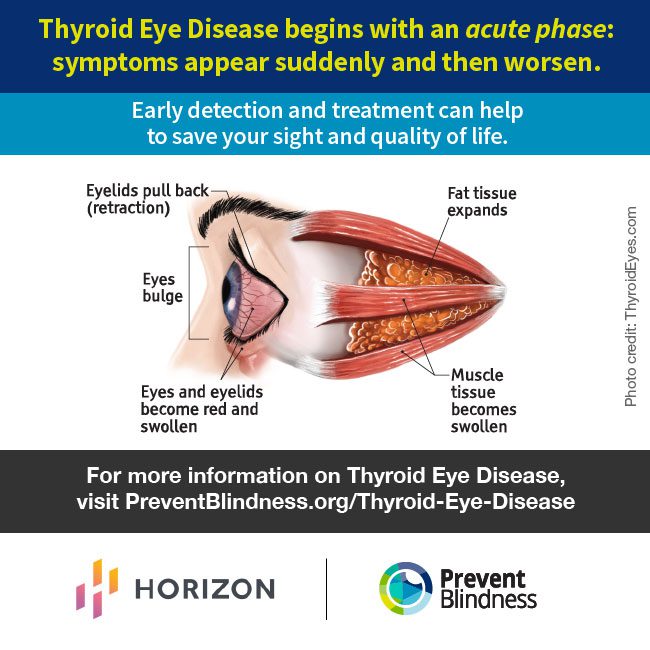Prevent Blindness offers no-cost educational materials, including fact sheets, graphics, and dedicated website to provide information on Thyroid Eye Disease
Prevent Blindness has declared Nov. 14-20, 2021 as the second annual “Thyroid Eye Disease Awareness (TED) Week.” As part of this initiative, Prevent Blindness will be promoting its TED resources including the dedicated webpage, fact sheets in English and Spanish, and posting a series of graphics on its social media channels, including Facebook, Twitter and Instagram.
Additionally, Prevent Blindness will debut its newest episode in the Focus on Eye Health Expert Series, “Thyroid Eye Disease” featuring Dr. Sara Wester, Associate Professor of Clinical Ophthalmology, Bascom Palmer Eye Institute, TED specialist and Oculoplastic Surgeon. The interview also features TED patient, Mr. Stephen Bander, who shares his personal experience with the disease. TED Awareness Week is supported by Horizon Therapeutics, a global biotechnology company focused on rare, autoimmune and severe inflammatory diseases. Prevent Blindness is also joining with Horizon Therapeutics in support of the new “IdentifEYE TED” educational campaign, designed to help people more quickly identify the signs and symptoms of TED.

According to the National Organization for Rare Disorders, TED affects more women than men, although men are more likely to have a severe form of the disease. Those who have a family member with the disease or a family member with an autoimmune disease are at a greater risk of developing the TED, and it is more likely to occur during middle age. The estimated prevalence of thyroid eye disease is estimated to be 16 per 100,000 women in the general population, and 2.9 per 100,000 men in the general population.
TED has a variety of symptoms including:
- Dry, gritty and irritated eyes
- Red eyes and/or watery eyes
- Puffy eyelids
- Sensitivity to light
- Blurry or double vision
- Appearance of misaligned eyes
- Bulging eyes (called proptosis) and lid retraction
Because TED may affect both vision and physical appearance, some TED patients may experience changes to their mental health, including depression, anxiety and self-consciousness. Prevent Blindness strongly advises patients with TED and their caregivers to talk to their doctor about any changes to their emotional well-being, to seek out support groups for those who have TED, and to avoid isolation by staying connected with family and friends.
“As with so many eye diseases and conditions, the earlier TED is diagnosed and treated, the greater the chance to save sight,” said Jeff Todd, president and CEO of Prevent Blindness. “We encourage everyone to talk to their doctor about the best ways to protect their sight and find treatments that are right for them.”
For more information on Thyroid Eye Disease, please visit preventblindness.org/thyroid-eye-disease/ or FOCUSonTED.com.
